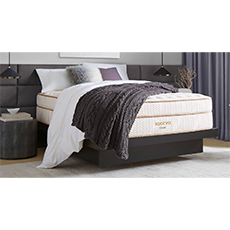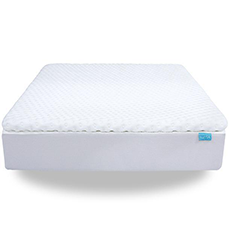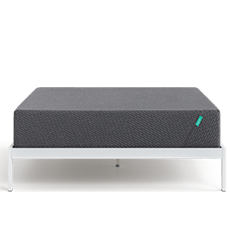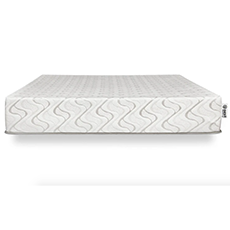Best Mattress Brands
 Puffy4.9(197)
Puffy4.9(197) Saatva Mattress3.3(3,736)
Saatva Mattress3.3(3,736) DreamCloud2.3(105)
DreamCloud2.3(105)
Our research team vetted 47 brands rated by more than 38,000 verified customers. Read our guide to choose the best mattress company for you by comparing mattress types, firmness levels and costs. See which mattress is right for you and the way you sleep.
- Our recommendations are based on what reviewers say.
- 4,426,419 reviews on ConsumerAffairs are verified.
- We require contact information to ensure our reviewers are real.
- We use intelligent software that helps us maintain the integrity of reviews.
- Our moderators read all reviews to verify quality and helpfulness.
Compare Top Mattress Reviews | ||||||
|---|---|---|---|---|---|---|
Offers memory foam mattresses in three styles. Queen-size mattresses start at $1,049. Sells mattresses online and through retailers. Provides a 101-night sleep trial, a lifetime warranty and free shipping and returns. | Shop Now | |||||
Offers multiple firmness options designed for optimal back support. Includes at least a 15-year warranty and a 180-night trial on all mattresses. Prices start at $935 for a twin mattress. |  | Shop Now | ||||
Sells hybrid mattresses starting at $899 for queen. Includes a 365-night, risk-free, in-home trial period with free shipping and returns. Provides a lifetime warranty. Financing available through third parties. | Shop Now | |||||
Sells three models of memory foam mattresses and three hybrid mattresses. Prices start at $699 for a queen. Offers 365-night, in-home trial. Lifetime warranty. Available online only. Bedding, frames and furniture available. |  | Shop Now | ||||
Specializes in polyfoam mattresses. Queen-size mattresses start at $895. Offers a 10-year warranty and a 100-night trial. Provides same-day shipping. Sells mattresses online and in select stores. | Shop Now | |||||
Offers natural and hypoallergenic latex mattresses made out of 100% natural latex. Provides a 20-year warranty. Mattresses start at $1,449 for a twin. Includes a 180-night in-home trial. |  | |||||
Offers eco-friendly memory foam mattresses starting at $949. Provides mattresses designed for all sleep positions and body types, with special considerations made for spinal alignment. Firmer mattresses also available. |  | Shop Now | ||||
Offers memory foam and hybrid mattresses online and through many retailers. Queen mattresses start at $449. Online purchases include a 120-night trial and free delivery, setup and mattress removal. Provides 10-year warranties. |  | Shop Now | ||||
Specializes in organic luxury mattresses. Includes a 100-night trial, lifetime comfort guarantees and free delivery. Queen mattresses range from $799 to $4,099, with the option to add other sleep products, like beds and bedding. |  | Shop Now | ||||
Online mattress retailer with a multitude of mattress and bedroom furniture options. Offers a 120-night in-home mattress trial, free delivery and optional financing. Promotions frequently available. | Chat with a ConsumerAffairs decision guide Live agent | |||||
Our picks for top mattresses
You spend roughly one-third of your life in bed, so it's important to find a quality mattress that fits your needs and lets you get good rest. However, with dozens of mattress brands on the market, it can be hard to determine which product is right for your sleep style (and budget).
Many mattress brands run frequent promotions that can save you hundreds of dollars.
Take a few minutes to compare a few mattress brands before making a purchase. We’ve gathered info on costs, trial periods, warranties and reviews below.
- Top-rated overall: Saatva Mattress
- Our picks for stomach sleepers: Luma Sleep and Leesa
- Our picks for side sleepers: Tuft & Needle and Helix Mattress
- Our pick for back pain: Craftmatic Adjustable Beds
- Our picks for couples: Nest Bedding and Sealy
- Our pick for allergies: Zenhaven
- Our pick for sweaty sleepers: Cocoon by Sealy
Compare our mattress picks
Below, compare our favorite options from some of our top-rated mattress brands.
| Starting costs* | Trial period | Warranty | |
|---|---|---|---|
| Saatva | $1,580 | 180 nights | 15 years |
| Luma Sleep | $1,195 | 100 nights | 10 years |
| Leesa | $1,099 | 100 nights | 10 years |
| Tuft & Needle | $895 | 100 nights | 10 years |
| Helix | $1,099 | 100 nights | 10 to 15 years |
| Craftmatic | Vary | 30 nights | 25 years |
| Nest Bedding | $799 | 100 nights | Lifetime |
| Sealy | $549 | 100 nights | 10 years |
| Zenhaven | $2,460 | 180 nights | 20 years |
| Cocoon by Sealy | $769 | 100 nights | 10 years |
*For a queen-size mattress, as of publishing date.
- Costs: $1,580 and up*
- Trial period: 180 nights
- Warranty: 15 years

*For a queen-size mattress, as of publishing date.
As of publishing, Saatva is the top-rated mattress company on our site. It offers hybrid, memory foam and specialty mattresses. It’s “a slice of heaven,” according to a reviewer in New York. “I never dreamed I could sleep so much better,” another reviewer in Georgia said. “It's cool, it's comfortable, it makes me want to go to bed!”
On the downside, some recent reviews refer to shipping delays (likely caused by COVID-19 supply chain issues). For more info, compare Saatva vs. Casper.
Our picks for stomach sleepers
Sleeping on your stomach can put extra strain on your body, so look for a firm, supportive mattress to ensure proper alignment and pressure relief.
- Costs: $1,195 and up*
- Trial period: 100 nights
- Warranty: 10 years

*For a queen-size mattress, as of publishing date.
Luma Sleep offers hybrid latex mattresses at varying firmness levels. Layers consist of foam, latex and coils, but the number of layers and their proportions differ by model. A reviewer in Arizona got one because they wanted an organic mattress, saying, “It's lovely and it doesn't smell bad. There's no off gap thing and it's very soft. I love it.”
- Costs: $1,099 and up*
- Trial period: 100 nights
- Warranty: 10 years

*For a queen-size mattress, as of publishing date.
Leesa offers memory foam and hybrid mattresses, all of which are medium-firm designs. While some stomach sleepers may want a firmer mattress, others might find a medium-firm mattress more comfortable for them or their partners.
Happy Leesa reviewers say their mattresses are comfortable and affordable. However, Leesa doesn’t offer as many cooling features as some other memory foam models do.
Still not sure? Check out four more mattresses for stomach sleepers.
Our picks for side sleepers
If you’re a side sleeper, look for a softer mattress that allows your hip and shoulder to sink in for proper spinal alignment. Memory foam mattresses can be good for this, but medium-soft or medium innerspring mattresses can also work well for side sleepers.
Softer mattresses aren’t recommended for most people because they don’t provide enough support for other sleeping positions, though.
- Costs: $895 and up *
- Trial period: 100 nights
- Warranty: 10 years

*For a queen-size mattress, as of publishing date.
Tuft & Needle offers three models, but its Mint Mattress is its best option for side sleepers because it’s the softest in the company’s lineup. The Mint Mattress is an all-foam design with cooling gel to help people that tend to sleep hot. However, this model is more expensive than Tuft & Needle’s other options, coming in at $1,195 for a queen-size model before any discounts.
- Costs: $1,099 and up*
- Trial period: 100 nights
- Warranty: 10 to 15 years

*For a queen-size mattress, as of publishing date.
Helix offers a wide range of mattress models, and each Helix mattress features individually pocketed coils to cradle your shoulders, spine and hips. Upgrades in its Helix Luxe line include zoned lumbar support, a breathable Tencel cover and additional comfort layers. Luxe models start at $1,949, and the Sunset Luxe model is the brand’s recommendation for side sleepers.
“Unboxing was straightforward, you slide it out of the box, align it with your base and cut open the plastic. It pops open and comes to life as soon as you cut the plastic,” according to a reviewer in New Jersey. Other mattress reviews say Helix is a great value for the money. However, a few reviews mention that its customer service could improve.
Still aren’t sure? Check out more of our mattress picks for side sleepers.
Our pick for back pain
If you have chronic back pain, finding the right mattress is critical. Firm mattresses provide good support for those with back problems. However, sometimes a mattress that is too firm can irritate joint pain. Depending on your sleeping position, you might consider medium-firm support, too.
- Costs: Vary
- Trial period: 30 nights
- Warranty: 25 years

Craftmatic primarily makes adjustable beds. Mattresses for its Model I and Legacy models come in four firmness levels, but Luxury Firm may be the right option for people with back pain.
One reviewer in Florida said it’s “especially good if you or your significant other have any health issues. For back sufferers or breathing issues, this bed is perfect.” However, there are a few reviews that mention delivery delays.
Still not sure? Check out our other picks for the top mattresses for back pain.
Our picks for couples
If you sleep with a partner, consider a mattress that reduces motion transfer. This means the mattress won’t move as much if your partner gets up or moves during the night.
Memory foam mattresses are often a good choice for couples because of their superior motion isolation. If you’re set on an innerspring mattress, look for one with motion-reducing coils, though.
- Costs: $799 and up*
- Trial period: 100 nights
- Warranty: Lifetime

*For a queen-size mattress, as of publishing date.
Nest Bedding offers a variety of mattresses with different constructions, but its Love & Sleep mattress is our recommendation for couples. Designed with a SmartFlow Air Flow layer of foam for cooling, it’s a good option for both hot sleepers and side sleepers. It’s also made in the United States, and it comes with a lifetime warranty.
Overall, most reviewers seem pleased with Nest Bedding. However, a few reviews mention that the mattresses are not true to size by an inch or two.
- Costs: $549 and up*
- Trial period: 100 nights
- Warranty: 10 years

*For a queen-size mattress, as of publishing date.
Sealy has several mattresses with varying features, but its top-of-the-line Posturepedic Plus Spring III is an innerspring mattress with motion-absorbing coils. This makes it a good option for couples who want to minimize motion but don’t like memory foam. However, this product line is expensive, with queen-size Posturepedic Plus mattresses starting at $1,099.
Reviewers are often enthusiastic about Sealy. “My wife and I are ‘old folks’ and really enjoy a good night's sleep (it's one of a few pleasures left). We need to rest and quiet all the aches and pains,” a reviewer in California said. “Nobody could go wrong buying this mattress, you'll never regret it.”
Our pick for hypoallergenic mattresses
Latex is naturally allergen-free and resistant to dust mites and mold, which makes latex mattresses a good choice for those struggling with indoor allergies.

*For a queen-size mattress, as of publishing date.
The Zenhaven mattress from Saatva is made from natural, eco-friendly materials. These materials also mean it’s hypoallergenic. Another nice feature is that it's flippable, giving you two distinct comfort options.
However, it’s relatively expensive, and a reviewer in California said the mattress is too heavy, which makes it difficult for them to replace the bed skirt.
Our picks for people who overheat
If you find yourself kicking off the covers in the middle of the night, look for a mattress that doesn’t retain heat.
Innerspring mattresses tend to be temperature neutral, so they can be a good choice when paired with a cooling pillow or a ceiling fan. Also, gel foam mattresses have cooling properties that make them a good alternative to traditional memory foam mattresses, which are known to sleep hot.
- Costs: $769 and up*
- Trial period: 100 nights
- Warranty: 10 years

*For a queen-size mattress, as of publishing date.
We’ve already covered another option from Sealy, but its Cocoon Chill Memory Foam Mattress is a good choice for hot sleepers who like a medium firmness. Although it doesn’t actually have a gel layer, it includes a cover with a proprietary “Phase Change Material” that absorbs and dissipates heat.
Still not sure? Read our guide on cooling mattresses for hot sleepers.
Types of mattresses explained
Mattresses come in a variety of different sizes, styles and materials, and each has its own pros and cons.
Innerspring mattresses
Construction: Innerspring mattresses use metal coils to provide support. Different coil styles offer varying levels of support and carry different price tags.
Pros: Innerspring mattresses are widely available, and there are many affordable options.
Cons: Metal coils can irritate pressure points and weaken over time, which means you may need to replace an innerspring mattress sooner than a mattress of another type.
Good for: Innerspring mattresses support a variety of sleep positions.
Memory foam mattresses
Construction: Memory foam mattresses are commonly made out of polyurethane, but open-cell and gel-infused memory foam variations are also popular.
- Open-cell foam is a more breathable type of foam that lets air escape and circulate. As a result, you sleep cooler while still getting the same pressure relief you would from traditional memory foam.
- Gel-infused memory foam is another cooling option. Foam mattresses that are gel-infused or contain a layer of gel help you regulate your temperature through the night.
Pros: Limited motion transfer makes memory foam mattresses ideal for those who sleep with a partner, and the extra support can help sleepers who suffer from back and joint pain.
Cons: You sink into the mattress, which some people find uncomfortable. Traditional memory foam mattresses are also known for retaining heat.
Good for: Memory foam mattresses are a great choice for side sleepers because they let your shoulder and hips sink into the mattress, which then cradles and supports them in a way spring mattresses can’t.
Latex mattresses
Construction: A latex mattress must have at least one layer of latex, but many contain multiple other materials in different layers.
Support: An extra foam layer is generally added to complete the core support of a latex mattress, but some companies manufacture latex-coil hybrid mattresses.
Pros: Latex mattresses are durable, and the firmness is good for relieving pressure points.
Cons: Latex mattresses tend to be more expensive than innerspring and memory foam mattresses.
Good for: Latex mattresses are a smart option for anyone concerned with allergens or looking for a durable, eco-friendly mattress.
Hybrid mattresses
Pros: Hybrid mattresses combine the qualities of multiple other types of mattresses. They often are also a little cheaper than memory foam mattresses.
Cons: Hybrid mattresses are heavy, which can make them difficult to move.
Good for: Hybrid mattresses are a useful option for a variety of people (depending on their composition), especially couples needing different features out of their mattresses.
If you’re looking into a hybrid mattress, you may also want to consider a pillow-top mattress, which is an innerspring mattress with a top layer of padding made of foam, latex, cotton, wool or other fibers.
» MORE: Mattress statistics
Mattress firmness comparison
Mattresses are frequently described in terms of their firmness (often on a scale of one to 10), so understanding what this means and how it impacts your sleep helps you narrow down which mattress is right for you.
- Soft mattresses: A soft mattress ranks between one and two on the 10-point mattress firmness scale, which means sleepers often feel as though they’re sinking into the bed. Soft mattresses are often recommended for side sleepers because they allow people’s hips and shoulders to align with the rest of their bodies. However, soft mattresses can trigger back pain in some individuals, including stomach sleepers and heavier people. A medium-soft mattress (three to four on the firmness scale) may be a better option for these kinds of sleepers.
- Medium mattresses: Sometimes referred to as universal comfort mattresses, medium mattresses (including medium-soft and medium-firm models) rank between three and seven on the firmness scale. These are a popular choice for all types of sleepers because they combine plush comfort with decent support. A medium-firm mattress is a great choice for couples.
- Firm mattresses: Ranging from six to ten on the firmness scale, firm mattresses allow sleepers to rest on top of their mattresses with little to no sinking in. Firm mattresses are recommended for stomach sleepers and heavier individuals.
To find your ideal mattress firmness, consider your preferred sleeping position, body weight, physical condition and whether you share the bed with a partner.
For instance, while a firmer mattress is often recommended for people who suffer from back pain, those who suffer from arthritis, inflammation or other joint issues may find that firm mattresses create too much pressure and actually make their pain worse. However, a mattress that is too soft can cause improper spinal alignment.
Ideally, people suffering from joint issues should find a mattress somewhere in the middle that strikes a balance between comfort and support.
How much is a mattress?
The average cost of a mattress is around $1,000 (for a queen-size model). Keep in mind that prices vary significantly depending on the mattress’s brand, size and type, so a queen mattress can cost anywhere from less than $500 to more than $5,000. No matter what size mattress you’re buying, there are ways to make the mattress-buying process more affordable, though.
Average prices by mattress size
| Size | Average cost |
|---|---|
| Twin mattress | $600 |
| Full mattress | $800 |
| Queen mattress | $1,050 |
| King mattress | $1,200 |
Based on innerspring designs
Average price by mattress type
| Type | Cost |
|---|---|
| Innerspring mattress | $1,050 |
| Memory foam mattress | $1,050 |
| Hybrid mattress | $2,000 |
| Latex mattress | $2,050 |
Based on queen mattresses
How to buy a mattress
Once you have an idea of what type of mattress you want, it’s time to go shopping. Here are some tips to make sure your purchase ends up being the right one.
- Test it out: The only way to know if you like a mattress is to lie on it. Don’t just lie down and jump back up, either. Be sure to test the mattress in the position you typically sleep in, particularly if you are a side sleeper, and stay in the position for a few minutes. If you have a partner, be sure to bring them along to get an idea of how the mattress handles motion transfer.
- Look for a generous trial period: It can take several weeks to fully adjust to a mattress. That’s why many companies offer extended trial periods. Some brands, particularly those who sell their mattresses exclusively online, offer 90- to 100-night sleep trials. A longer trial period takes some of the fear out of buying a mattress because you can change your mind and try something else if needed. Just make sure you know the trial rules for each brand.
- Try more than one: Compare and contrast different styles and levels of firmness if you have the chance. However, trying too many mattresses can be confusing and ultimately muddle your experience. Try two to three models in the type you’re leaning toward, and add in one more you might not have considered just for context.
- Negotiate the price: Salespeople know you have nearly endless options when buying a mattress. Like when buying a car, this means they may be willing to offer a discount or rebate, and they may even upgrade you to a nicer mattress for the same price as a less expensive model. Don’t push too hard, though; not all brands are willing to negotiate.
- Ask about the warranty: Like any major purchase, mattresses often come with a warranty. Some warranties even extend well beyond the typical lifespan of a mattress. It’s worth finding out what might void the warranty, though.
- Check the thickness and layers: Most mattresses range between 8 to 12 inches thick and usually include two to five layers. The top layers deliver the comfort and cooling properties, while the bottom layers provide the foundation and compression support. In good mattresses, the foundation should be at least half of the mattress’s thickness. Each layer should be at least 2 inches thick. Increased padding often indicates a higher-quality bed; plus, the thicker the mattress, the longer it typically lasts.
A longer trial period takes some of the fear out of buying a mattress because you can change your mind and try something else if needed.”
Tips for buying a mattress online
There are pros and cons to buying a mattress in-store versus buying online. You may be able to get a better deal online, but you can only test a mattress before you buy it by visiting a store or showroom in person. However, most online mattress brands offer a decent in-home trial period to help give customers confidence in their purchase.
Buying a mattress online is a fairly simple process. You just need to know the style of mattress you want in advance. Here’s how to go about it:
- Determine the type of mattress you want
- Set a budget
- Read customer reviews
- Look for brands that offer generous in-home trial periods
- Select a mattress that offers a minimum 10-year warranty
Mattress FAQ
How long does a mattress last?
The Better Sleep Council recommends disposing of your mattress and replacing it every seven years. However, the effective life span of your mattress really depends on how you use it, your body type and the environment you live in. Higher-quality mattresses may last longer due to their superior materials and construction, but even expensive mattresses have an expiration date.
How do you know it’s time to replace your mattress?
Signs that it’s time to replace your mattress include:
- Waking up with neck or back pain, stiff limbs or a tired feeling even after a full night’s sleep
- Frequently tossing and turning or waking up throughout the night
- Low spots or visible sagging in your mattress
- Your mattress suddenly starting to creak
- Your allergies growing worse, especially when it isn’t your typical allergy season
- Finding a mattress you like more
How do I choose a mattress?
There are a few things to consider when choosing a new mattress, such as your:
- Budget
- Sleeping position
- Weight
- Personal preferences
Your sleeping position and weight are crucial factors to consider when purchasing a new mattress because they determine the level of firmness you need.
Which is the most comfortable mattress?
No mattress is the most comfortable for all people. How well you like a given mattress depends on the details of your sleeping position, weight and other preferences. Still, it’s hard to find the right mattress if you’re researching exclusively online. The surest way to determine if a mattress is comfortable for you is to try it out and see for yourself.
What is the best time to buy a mattress?
New mattress models typically are rolled out in June each year, making May the best time to find clearance offers. However, it's not always ideal to put off buying a mattress to wait for a sale, especially if your current mattress is causing pain or sleepless nights. Many mattress sellers offer affordable financing programs that can get you into a better mattress soon.
Thanks for subscribing.
You have successfully subscribed to our newsletter! Enjoy reading our tips and recommendations.
Compare Top Mattress Reviews | ||||||
|---|---|---|---|---|---|---|
Offers adjustable sleep systems that attach to any head or footboard. Prices vary between $2,500 and $6,000 and are determined by an in-home consultation. Includes a lifetime warranty. |  | Chat with a ConsumerAffairs decision guide Live agent | ||||
Offers hybrid memory foam and innerspring mattresses designed to suit every body type. Provides a sleep quiz to help you find a mattress match. Mattresses start at $699. Includes a 100-night sleep trial. | ||||||
Specializes in inflatable air mattresses with built-in pumps. Queen beds start around $110, but prices vary by retailer. Mattresses available from Amazon, Costco, Target and Bed Bath & Beyond. |  | Chat with a ConsumerAffairs decision guide Live agent | ||||
Specializes in mattresses with customizable support. Queen-size mattresses start at $1,099. Offers financing to approved customers. Includes a 100-day return policy and a 15-year warranty. |  | Chat with a ConsumerAffairs decision guide Live agent | ||||
Sells hybrid, gel-foam and latex mattresses. 18-month, risk-free mattress trial. Free shipping and returns. Lifetime warranty. Flexible financing options available. Also offers bed frames and accessories. |  | Chat with a ConsumerAffairs decision guide Live agent | ||||
Offers memory foam, hybrid and innerspring mattresses. Offers a 100-day trial, free delivery and a 10-year warranty. Queen mattresses start at $172 and can be purchased with frames and foundations. |  | Shop Now on Amazon | ||||
Sells other brands’ mattresses online and in stores in select regions. Queen sizes start at $229. Includes a 120-night trial, a 120-day price promise, free delivery and manufacturer-based warranties. Offers financing and layaway. |  | Chat with a ConsumerAffairs decision guide Live agent | ||||
Offers foam and hybrid mattresses. Offers 100-night trials, 10-year warranties, and free shipping and returns. Queen mattresses range from $1,095 to $2,695. Sells bed frames and other products. |  | Shop Now | ||||
Sells overstock name-brand mattresses. Queen sizes start at $199.99. Provides a 24-hour cancellation policy, manufacturer-based warranties and free in-store pickup where available. Charges up to $299 for shipping. |  | Chat with a ConsumerAffairs decision guide Live agent | ||||
Specializes in certified organic and natural latex and foam mattresses. Prices start at $378 for sofa bed mattresses and $1.985 for regular mattresses, but discounts are available. Offers 100-night trials and free shipping. |  | Chat with a ConsumerAffairs decision guide Live agent | ||||
Offers three models of mattress. Products are made out of foam and Purple’s proprietary grid. Mattresses start at $699 and come with a 100-night trial and a 10-year warranty. Free shipping and returns. |  | Chat with a ConsumerAffairs decision guide Live agent | ||||
Focuses on environmentally friendly and vegan mattresses. Queen mattress costs $1,599. Mattresses are made in the U.S. Includes a 25-year warranty and one-year sleep trial. Offers free shipping to all 50 states. |  | Chat with a ConsumerAffairs decision guide Live agent | ||||
Offers latex and gel memory foam mattresses. Four models available. Prices start at $1,295 for a queen. Offers a 20- or 25-year warranty and a 101-day sleep trial. Financing available through third parties. | Chat with a ConsumerAffairs decision guide Live agent | |||||
Specializes in a medium-firm hybrid latex mattress. Queen-size mattresses start at $2,098, with discounts available. Offers a 365-night in-home trial period and free shipping and returns. Sells platforms and adjustable frames. |  | Chat with a ConsumerAffairs decision guide Live agent | ||||
Sells mattresses in chain stores throughout the U.S. and online. Stocks a selection of mattresses under $500 as well as more expensive, premium mattresses. Provides payment plans and financing options. | Chat with a ConsumerAffairs decision guide Live agent | |||||
Offers a breathable, nontoxic mattress made from cotton, wool and natural latex. Toppers, pillows, frames and foundations also available. Includes free shipping, a 100-night sleep trial and a 25-year warranty. Financing available. |  | Chat with a ConsumerAffairs decision guide Live agent | ||||
Offers luxury memory foam and hybrid mattresses. Includes a 90-night trial, 10-year warranty and free delivery. Queen-size mattresses start at $1,999. Bases, foundations and other add-ons available. |  | Chat with a ConsumerAffairs decision guide Live agent | ||||
Traditional, boxed and luxury mattresses offered in-store and through online retailers. Warranties up to 10 years. Sellers determine trials, delivery and return. Queen mattresses range from $349 to $579. |  | Chat with a ConsumerAffairs decision guide Live agent | ||||
Offers innerspring, memory foam and hybrid mattresses through in-store and online retailers. Queen-size mattresses start at $549. 10-year warranties available. Trials, deliveries and returns vary by seller. 100-night trial. |  | Chat with a ConsumerAffairs decision guide Live agent | ||||
Sells brand-name mattresses online and in retail locations across New York. Queen mattresses start at $219. Financing available. Includes a 30-day comfort trial. Also offers beds and bedding. | Chat with a ConsumerAffairs decision guide Live agent | |||||
Sells several adjustable bed models and mattresses. 30-day in-home trial. Frames and mattresses come with limited lifetime warranties. Features include remote control and massage capabilities. Available in twin to California king. |  | Chat with a ConsumerAffairs decision guide Live agent | ||||
Provides mattresses in various different constructions. Available in stores and from online retailers. Queen-size mattress costs between $1,899 and $4,599. Shipping and returns vary by seller. Includes 10-year warranties. |  | Chat with a ConsumerAffairs decision guide Live agent | ||||
Operates retail store locations throughout California. Offers competitive price guarantee and free local delivery on select products. Queen mattresses from major brands start at $449.99. Includes a 120-night sleep trial. |  | Chat with a ConsumerAffairs decision guide Live agent | ||||
Offers memory foam and hybrid mattresses starting at $695. Mattresses made with a Celliant cover to help keep it cool throughout the night. Includes a 100-night in-home trial and a 10-year warranty. |  | Chat with a ConsumerAffairs decision guide Live agent | ||||
Offers cool-gel, eco-friendly, memory foam mattresses that transform into couches. Queen size starts at $499.99. Includes a 30-day trial, 10-year warranty and free delivery. Comes in five colors. Optional adjustable base. |  | Chat with a ConsumerAffairs decision guide Live agent | ||||
Offers latex and foam mattresses in four styles. Prices start at $795. Includes a 100-night trial, 10- to 15-year warranties and free delivery. Other sleep products available, including beds and bedding. |  | Chat with a ConsumerAffairs decision guide Live agent | ||||
Specializes in luxury hybrid mattresses made from all-natural, eco-friendly materials. Offers latex and gel options. Prices start at $399 for a twin. Includes a 25-year warranty and one-year trial. Mattresses made in the U.S. | Chat with a ConsumerAffairs decision guide Live agent | |||||
Sells select name-brand mattresses in person only. Operates store locations throughout the U.S. Includes one- to 10-year warranties. Prices, returns and trials vary by brand. |  | Chat with a ConsumerAffairs decision guide Live agent | ||||
Sells memory foam, latex and hybrid mattresses at retail stores throughout the Southeast. Offers one- to 20-year warranties and free in-store pickup. Pricing, trials, delivery and returns may vary by retail location. |  | Chat with a ConsumerAffairs decision guide Live agent | ||||
Sells memory foam and hybrid mattresses online. Prices start at $449. Includes a 120-night trial and a 10-year warranty. Offers free returns. Stocks traditional and adjustable bases as well. | Chat with a ConsumerAffairs decision guide Live agent | |||||
Offers memory foam and hybrid mattresses. Sells direct-to-customer. Available on Amazon. Queens start at $349.99. Includes a 10-year warranty, 120-night trial and free shipping and returns. | Chat with a ConsumerAffairs decision guide Live agent | |||||
Offers latex and foam mattresses in four styles. Prices start at $769. Includes a 100-night trial, 10- to 15-year warranties and free delivery. Other sleep products available, including beds and bedding. |  | Chat with a ConsumerAffairs decision guide Live agent | ||||
Offers memory foam and hybrid mattresses. Queen mattresses start at $1,099. Includes a 100-night sleep trial and a 10-year warranty. Test in person at various furniture and department stores. |  | Chat with a ConsumerAffairs decision guide Live agent | ||||
Offers smart mattresses with heating and cooling technology. Tracks sleep metrics with a free app. 100 night risk-free trial. Free shipping and returns. Prices start at $3,095 for a queen mattress. |  | Chat with a ConsumerAffairs decision guide Live agent | ||||
Offers U.S.-made mattresses constructed of CertiPUR-US-certified foam. Includes a “forever” warranty and 365-night in-home trial. Offers multiple firmness levels. Provides free shipping and returns. |  | Chat with a ConsumerAffairs decision guide Live agent | ||||
Sells foam, latex and hybrid mattresses along with other bedding. Mattress prices start at around $899. Offers free shipping, a 120-night trial period and a lifetime warranty. Financing options available. Made in the U.S. |  | Chat with a ConsumerAffairs decision guide Live agent | ||||
Information in this guide is general in nature and is intended for informational purposes only; it is not legal, health, investment or tax advice. ConsumerAffairs.com makes no representation as to the accuracy of the information provided and assumes no liability for any damages or loss arising from its use.
Want your company to be on this guide?
Yes, continueYou’re signed up
We’ll start sending you the news you need delivered straight to you. We value your privacy. Unsubscribe easily.